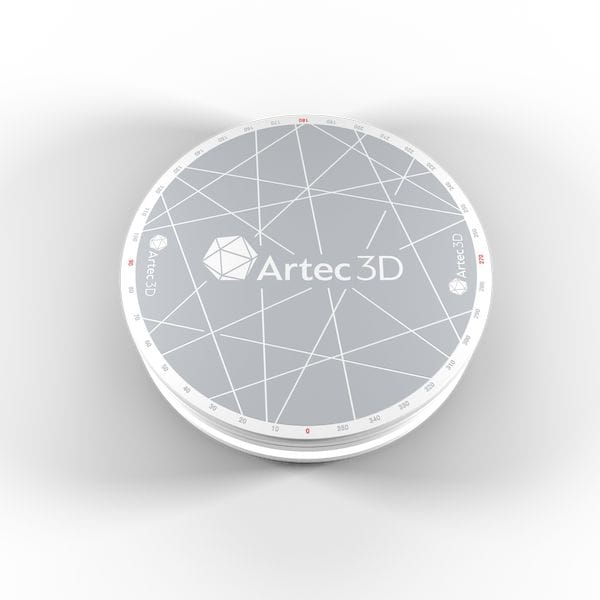![The new Artec Turntable accessory for 3D scanning [Source: Artec 3D]](https://fabbaloo.com/wp-content/uploads/2020/05/image-asset_img_5eb0945706fa4.jpg)
Artec 3D announced a new product: the Artec Turntable.
This small device is intended to enable the 3D scanning of very small objects at high resolution in a manner that’s a lot easier than their previous approach. Objects are placed on the turntable and rotated for 3D scanning.
To be clear, this is only a turntable and not a complete 3D scanning system; you must pair the turntable with a fixed 3D scanner, which become the “eyes” of the whole scanning system.
Artec 3D is well known for their relatively inexpensive line of powerful handheld 3D scanners. These devices are commonly used to capture high-resolution scans of engineering objects, structures and even people — as long as they remain still during the scan, of course.
Only their large-scale 3D scanning Ray system, intended for scanning huge structures, is a fixed device on a tripod. All their other products are handheld. This means you must slowly move the scanner around the object to perform the capture.
Handheld 3D Scanning
But human motions are erratic and thus for the tiniest objects with delicate geometries, this is perhaps not the best approach. Now, Artec 3D has produced a solution: the Artec Turntable.
Here’s how it works: the Artec Turntable is set up in front of a handheld 3D scanner that’s mounted in a stationary position. The scan begins by the Artec Turntable slowly rotating the object in front of the scanner, and gradually the scan is obtained.
I am sure you are thinking this is not a big deal, as anyone can simply mount a scanner and plop a subject on a rotating platform, perhaps even a cheap kitchen “lazy susan”. That’s not what this is at all.
In the “kitchen” approach, you would have to carefully synchronize the scanner’s activity with the capture software and also with the turntable motion. This would require an operator to be present during the entire scan.
Automating 3D Scanning
![The new Artec Turntable accessory for 3D scanning [Source: Artec 3D]](https://fabbaloo.com/wp-content/uploads/2020/05/image-asset_img_5eb094576634e.jpg)
The Artect Turntable solves this dilemma by automating almost everything. The turntable is motorized and turns at a constant rate, but it is controlled via Bluetooth by the capture software itself, Artec Studio. This same software is also in communication with the scanner, so all three elements are synchronized.
This means that if, for example, scan tracking is somehow lost during the rotation, the software can immediately detect this and reverse the turntable rotation until it’s caught again. Artec 3D believes this will be a feature that new users will appreciate, and I don’t doubt it, having lost tracking on 3D scans many a time.
Artec 3D Space Spider
Artec 3D recommends using their popular Artec Space Spider 3D scanner with the Artec Turntable, as it provides a 0.05mm accuracy and can capture up to 7.5 frames per second when operating. Essentially, this combination should provide a faster, more reliable small-object scan experience, along with a presumably better quality result.
One question that I pondered was how the turntable setup could capture the underside of the subject, or other areas within the geometry that would remain hidden during rotation. The answer is obvious: complete a scan, then replace the object on the turntable in a different orientation and repeat. The two (or more if necessary) scans can then be bolted together in 3D software later to complete the capture.
Via Artec 3D











